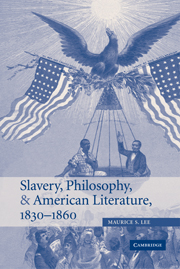Book contents
- Frontmatter
- Contents
- Acknowledgments
- Introduction
- 1 Absolute Poe
- 2 “Lord, it's so hard to be good”: affect and agency in Stowe
- 3 Taking care of the philosophy: Douglass's commonsense
- 4 Melville and the state of war
- 5 Toward a transcendental politics: Emerson's second thoughts
- Epilogue: An unfinished and not unhappy ending
- Index
5 - Toward a transcendental politics: Emerson's second thoughts
Published online by Cambridge University Press: 22 September 2009
- Frontmatter
- Contents
- Acknowledgments
- Introduction
- 1 Absolute Poe
- 2 “Lord, it's so hard to be good”: affect and agency in Stowe
- 3 Taking care of the philosophy: Douglass's commonsense
- 4 Melville and the state of war
- 5 Toward a transcendental politics: Emerson's second thoughts
- Epilogue: An unfinished and not unhappy ending
- Index
Summary
In their writings on the slavery crisis, Poe, Stowe, Douglass, and Melville treat topics that are recognizably philosophical – the constitution of reality, the foundations of moral authority, the operations of the mind, representation and language. Still, addressing philosophical topics and drawing on available philosophical concepts may not be the same thing as doing philosophy, at least insofar as the authors in question do not employ the rigorous logical methods of formal philosophical analysis and ultimately seem most interested in applying, not inventing or discovering, philosophical ideas. Emerson is similarly improvisational and opportunistic, but he has more cachet in philosophical circles. Though Emerson was seldom a systematic student, he read widely and intensely in philosophy, and though for most professional philosophers he remains on the margins of the field, he directly influenced Nietzsche and the pragmatists and has been the subject of powerful work by Stanley Cavell and Cornel West. As Lawrence Buell has recently suggested, whether we call Emerson a philosopher or not may have more to do with definitions of philosophy than with Emerson's lifelong, if somewhat idiosyncratic, dedication to epistemology and ethics. Such dedication, along with his growing participation in the abolitionist movement, might rightly make Emerson the star of a book about the conjunction of slavery and philosophy in antebellum American literature.
Yet the intersections of philosophy and the literature of slavery cannot be centripetally structured around a single writer, for even as canonical a thinker as Emerson is in many ways an anomalous figure in this book.
- Type
- Chapter
- Information
- Slavery, Philosophy, and American Literature, 1830–1860 , pp. 165 - 209Publisher: Cambridge University PressPrint publication year: 2005



